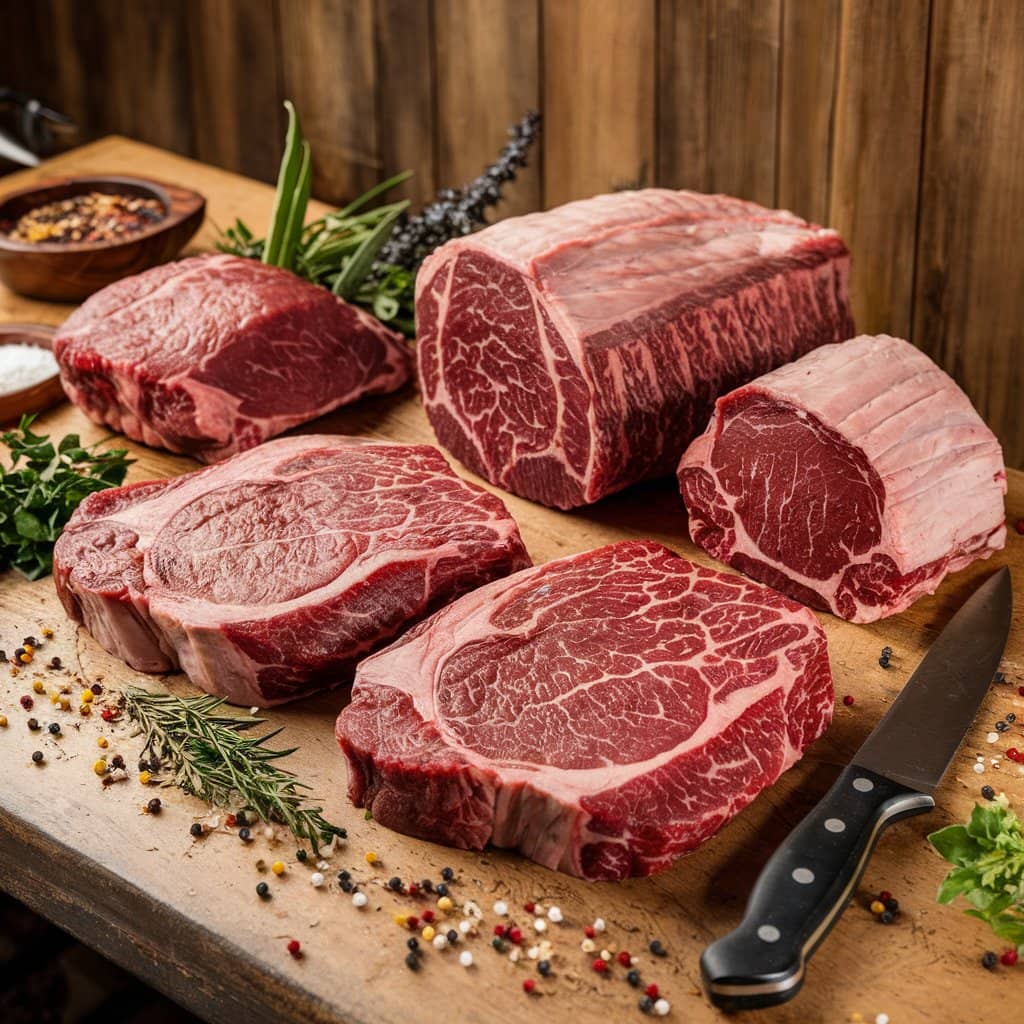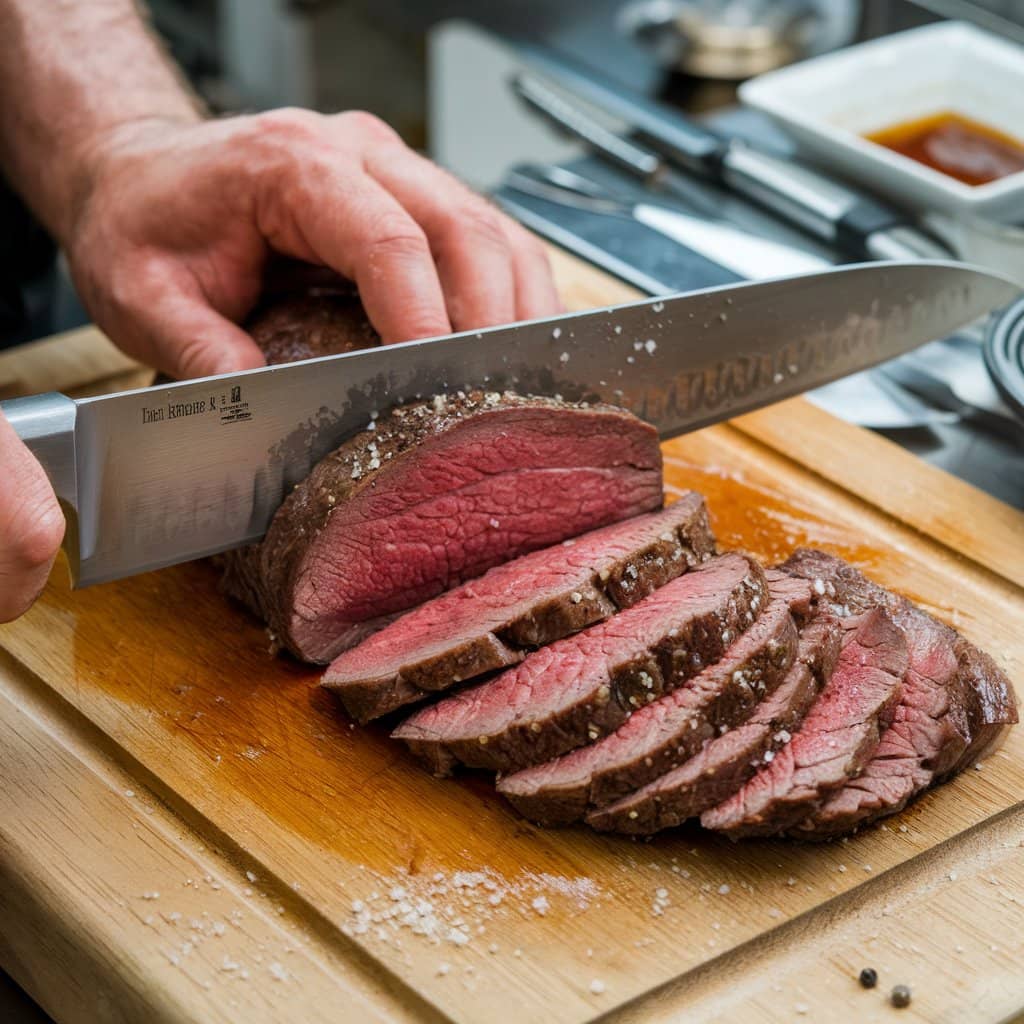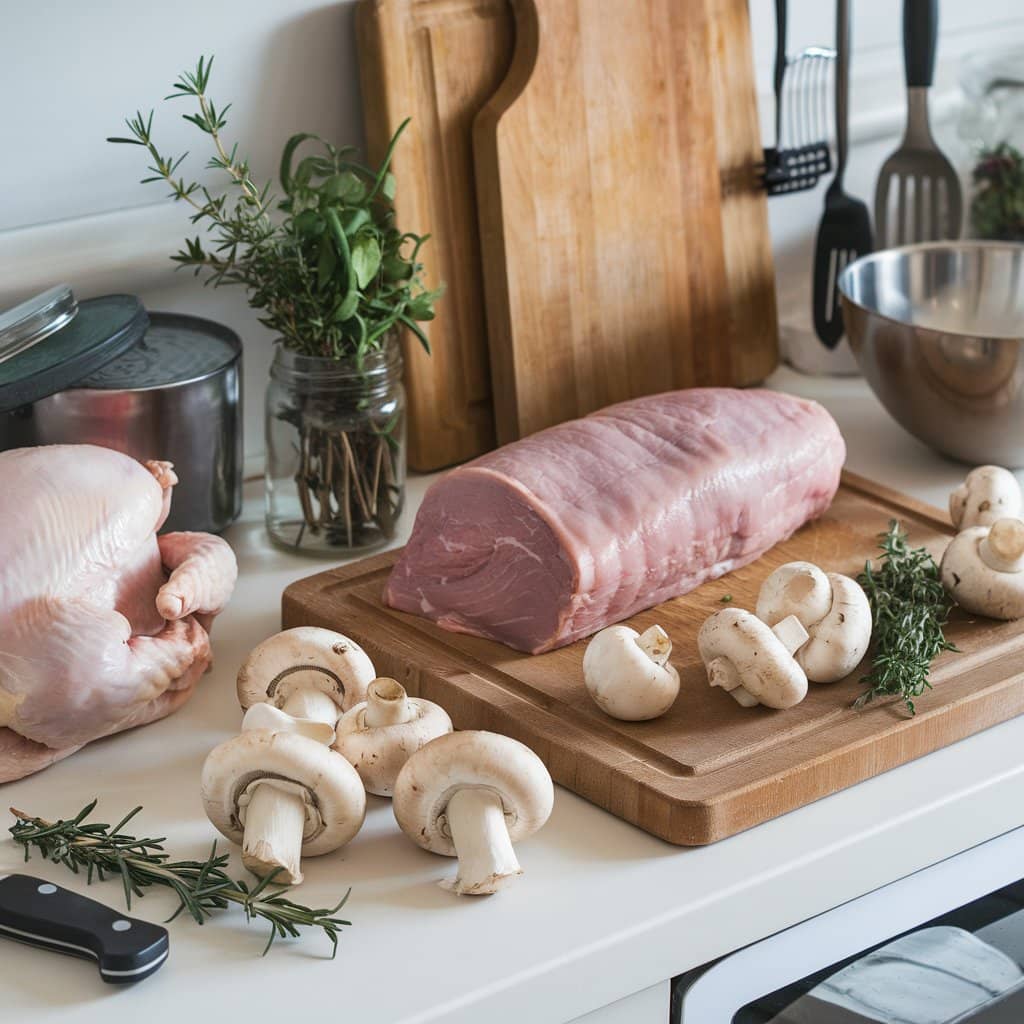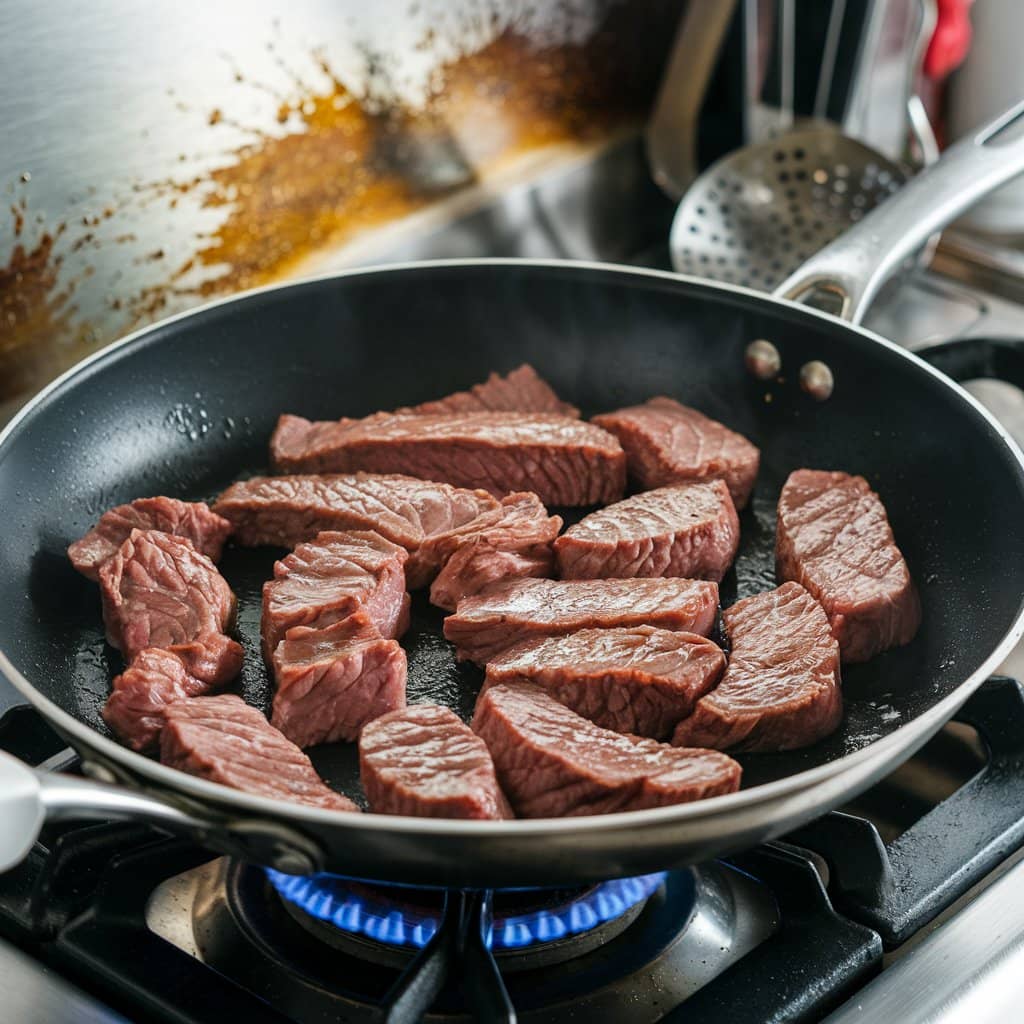What Cut of Meat Is Best for Beef Stroganoff? Beef Stroganoff is a classic dish known for its rich and creamy flavor. Originating from Russia, it has gained worldwide popularity due to its comforting taste and relatively simple preparation. While the sauce plays a key role, the quality of meat is equally essential. Choosing the right cut can make the difference between a tender, juicy Stroganoff and a tough, chewy one. This article will explore the best cuts of meat for Beef Stroganoff, preparation tips, and common mistakes to avoid.
Table of contents
Best Cuts of Meat for Beef Stroganoff
Choosing the right cut of meat is crucial for making a tender and flavorful Beef Stroganoff. Since the dish involves quick searing and simmering in a creamy sauce, selecting cuts that balance tenderness, flavor, and cooking efficiency is essential. Here are the top meat cuts recommended for Beef Stroganoff:

1. Why Tenderloin Is the Best Cut of Meat for Beef Stroganoff
Beef tenderloin is often considered the best cut for Beef Stroganoff due to its unmatched tenderness. This lean, mild-flavored meat cooks quickly, making it ideal for fast recipes. However, tenderloin can be expensive, so it’s best for special occasions.
Why Use It?
- Extremely tender and flavorful
- Cooks quickly, reducing prep time
Preparation Tip: Slice the tenderloin into thin strips against the grain to preserve its tenderness during cooking.
2. Using Sirloin for Beef Stroganoff: Is It the Best Cut of Meat?
Sirloin steak is a more affordable alternative that still provides great tenderness and flavor. It works well for Beef Stroganoff when sliced thinly and cooked briefly to avoid toughness.
Why Use It?
- More budget-friendly than tenderloin
- Has a balance of tenderness and robust beefy flavor
Preparation Tip: Opt for top sirloin instead of bottom sirloin for better tenderness. Slice against the grain for best results.
3. Is Ribeye the Best Cut of Meat for Beef Stroganoff?
Ribeye is known for its exceptional marbling, which enhances the dish’s overall richness. Its fat content ensures juicy, flavorful bites, though it can be pricier than sirloin.
Why Use It?
- Rich, beefy taste due to higher fat content
- Stays juicy even after cooking
Preparation Tip: Trim excess fat if you prefer a leaner sauce, but keep enough for added flavor.
4. Can Flank Steak Be the Best Cut of Meat for Beef Stroganoff?
Though tougher than tenderloin or sirloin, flank steak is a good budget option if prepared properly. Its bold beef flavor works well in Stroganoff, especially when thinly sliced and quickly seared.
Why Use It?
- Strong, beefy taste
- Affordable and widely available
Preparation Tip: Marinate the flank steak for extra tenderness and slice thinly against the grain.
5. Why Chuck Roast Works for Slow-Cooked Beef Stroganoff
While not traditionally used for quick-cooked Stroganoff, chuck roast is perfect for slow-cooker versions. Its higher fat and connective tissue content break down over long cooking, resulting in an incredibly tender and flavorful dish.
Why Use It?
- Great for slow-cooked Stroganoff recipes
- Becomes fall-apart tender when simmered
Preparation Tip: Sear the meat before slow cooking to lock in flavor.
Factors to Consider When Choosing the Meat for Beef Stroganoff
Selecting the best cut of meat for Beef Stroganoff involves more than just picking a popular steak. Several factors influence the final taste and texture of the dish. Let’s explore the key considerations when choosing the ideal cut of beef.
1. Tenderness Matters When Choosing the Best Cut of Meat for Beef Stroganoff
Tenderness is crucial for Beef Stroganoff because the meat is cooked quickly to preserve its softness. Cuts like tenderloin, sirloin, and ribeye are naturally tender and require minimal cooking time. Tougher cuts, such as flank or chuck roast, can be used if properly prepared, such as through marination or slow cooking.
Pro Tip:
- Choose cuts with minimal connective tissue for fast-cooked Stroganoff.
2. Flavor and Marbling Affect the Best Cut of Meat for Beef Stroganoff
Marbling refers to the white streaks of fat running through the meat. Well-marbled beef, such as ribeye, enhances flavor and juiciness as the fat melts during cooking. If you prefer a leaner dish, opt for less marbled cuts like tenderloin.
Why It Matters:
- More marbling = richer flavor and juicier texture
3. Flavor
The intensity of beef flavor varies depending on the cut. For a mild taste, choose tenderloin, while ribeye or flank steak offers a deeper, more robust beef flavor. If you’re aiming for maximum richness, a mix of meat cuts can add complexity.
Best Picks for Strong Flavor:
- Ribeye, flank steak, and chuck roast
4. Cost
Budget plays a significant role in selecting the right beef cut. Tenderloin is premium and pricey, while sirloin and flank steak offer a good balance of quality and affordability. Chuck roast is the most cost-effective for slow-cooked recipes.
Budget-Friendly Cuts:
- Sirloin, flank steak, chuck roast
5. Availability
Depending on where you live, certain cuts may be easier to find than others. In most supermarkets, sirloin and flank steak are readily available, while tenderloin and ribeye may be more specialized cuts. Local butchers can be a reliable source for higher-quality meats.
Tip for Better Selection:
- Shop at butcher shops for specific cuts if unavailable in your local grocery store.
How to Prepare the Best Cut of Meat for Beef Stroganoff
Even the best cut of meat can result in a disappointing Beef Stroganoff if not prepared correctly. Following proper preparation techniques ensures a tender, flavorful, and perfectly cooked dish. Here are essential preparation tips for Beef Stroganoff:

1. Proper slicing, marinating, and cooking techniques.
Proper slicing is essential for achieving tender meat in Beef Stroganoff. In fact, the golden rule is to slice the meat against the grain, as this shortens the muscle fibers and thus makes the beef easier to chew.
How to Slice the Meat:
- Use a sharp knife for clean cuts.
- Identify the grain direction (the lines running along the meat).
- Slice perpendicular to these lines into thin strips, about 1/4-inch thick.
2. Marinating the Meat (Optional)
While not always necessary, marinating tougher cuts like flank steak or chuck roast can enhance tenderness and add flavor. Simple marinades with ingredients like soy sauce, Worcestershire sauce, garlic, and olive oil work well.
Marinating Tips:
- Marinate for at least 30 minutes or up to 4 hours for tougher cuts.
- Avoid acidic marinades for tender cuts like tenderloin, as they can break down the meat too much.
3. Proper Searing
Searing the meat at high heat helps develop a flavorful crust and locks in juices. Avoid overloading the pan, as overcrowding can cause the meat to steam rather than sear.
How to Sear Perfectly:
- Preheat the pan over medium-high heat.
- Add a splash of oil with a high smoke point (like canola or vegetable oil).
- Sear the beef strips in batches, cooking for 1-2 minutes per side.
- Remove and set aside to avoid overcooking.
Beef Stroganoff is a quick-cooking dish, especially when using tender cuts like tenderloin or sirloin. Overcooking the meat can lead to dryness and toughness. Cook the beef just until browned, then return it to the pan after the sauce is prepared for a quick finish.
4. Cooking Time
Best Cooking Practices:
- For tender cuts: Cook for 5-7 minutes total.
- For tougher cuts (slow-cooker method): Simmer for 2-4 hours.
5. Sauce Integration
The beef should be reintroduced to the pan only after the sauce is prepared. This step ensures the meat stays juicy while soaking up the creamy sauce’s flavors.
Sauce Tips:
- Use beef broth, sour cream, and Dijon mustard for a rich, balanced sauce.
- Add a splash of white wine or brandy for extra depth.
6. Resting the Meat
Allow the cooked beef to rest for a few minutes before serving. This step redistributes the juices, ensuring every bite is moist and flavorful.
Why It Matters:
- Resting prevents juices from spilling out, maintaining tenderness and flavor.
Alternative Meats for Beef Stroganoff
Beef Stroganoff is traditionally made with cuts of beef, but there are several alternative meats and meat substitutes that can be used to create delicious variations of this classic dish. These options are perfect for dietary preferences, budget considerations, or simply adding a unique twist to the recipe.

1. Ground Beef
Ground beef is one of the most popular alternatives for Beef Stroganoff, thanks to its affordability and easy preparation. It creates a heartier, more filling version of the dish while still delivering rich, beefy flavor.
Why It Works:
- Budget-friendly and widely available
- Cooks quickly and absorbs the sauce well
Cooking Tip: Brown the ground beef until fully cooked, breaking it up into smaller pieces for even distribution in the sauce.
2. Pork (Pork Tenderloin or Ground Pork)
Pork tenderloin or ground pork serves as a lean and flavorful substitute. Additionally, pork’s mild taste pairs well with the creamy sauce, resulting in a delicious variation of the classic dish.
Why It Works:
- Similar texture to beef when using tenderloin
- A unique twist with a slightly sweet undertone
Cooking Tip: Avoid overcooking pork tenderloin to prevent dryness. Cook until just done for the best texture.
3. Chicken (Breast or Thighs)
is a lighter, leaner alternative that works well in Stroganoff. Chicken breasts provide a low-fat option, while thighs offer more juiciness and richer flavor.
Why It Works:
- Mild, adaptable flavor
- Suitable for those avoiding red meat
Cooking Tip: Use boneless, skinless chicken breasts or thighs. Sear them until golden brown before making the sauce.
4. Turkey
Turkey is another lean protein option that fits well into Beef Stroganoff recipes. Ground turkey can replace ground beef, while turkey breast strips can be used in place of steak cuts.
Why It Works:
- Low in fat and calories
- Absorbs sauce flavors effectively
Cooking Tip: Use dark turkey meat for more flavor and avoid overcooking to keep it tender.
5. Meatless Alternatives (Vegetarian/Vegan Options)
For plant-based versions, several meatless options are available that can effectively create a satisfying Stroganoff:
- Mushrooms: Portobello or cremini mushrooms provide a meaty texture and umami flavor.
- Tofu: Firm or extra-firm tofu, pressed and pan-fried, works well with the sauce.
- Seitan: A high-protein meat substitute that mimics beef in texture and flavor.
- Plant-Based Meat Crumbles: Available at most grocery stores, these mimic ground beef and cook quickly.
Why They Work:
- Great for vegetarians and vegans
- Provide protein while maintaining Stroganoff’s creamy texture
Cooking Tip: Sauté mushrooms or tofu until browned to add depth of flavor before adding them to the sauce.
Mistakes to Avoid When Choosing the Best Cut of Meat for Beef Stroganoff
Even experienced cooks can run into issues when making Beef Stroganoff. From selecting the wrong meat to mishandling the sauce, avoiding these common mistakes will ensure a delicious, tender, and flavorful dish every time.

1. Avoid overcooking, selecting the wrong cut, or skipping searing.
One of the biggest mistakes is using tough cuts of meat that require long cooking times. Avoid cuts like brisket, stewing beef, or bottom round unless you plan to slow-cook the dish.
Solution:
- Use tender cuts like beef tenderloin, sirloin, or ribeye for quick recipes.
- If using tougher cuts like chuck roast, opt for a slow-cooker method.
2. Overcooking the Meat
Beef Stroganoff is meant to be tender, but overcooking the meat can leave it dry and chewy. Since the beef is cooked quickly, keep a close eye on the cooking time.
Solution:
- Sear the meat quickly over high heat (1-2 minutes per side).
- Remove the meat after searing and return it to the sauce only at the end of cooking.
3. Skipping the Sear Step
Skipping the searing step can result in bland, flavorless meat. Moreover, searing locks in juices while also adding a deep, savory flavor that significantly enhances the entire dish.
Solution:
- Always preheat the pan to medium-high heat before adding the beef.
- Sear in small batches to avoid overcrowding the pan.
4. Making a Thin or Broken Sauce
A watery or curdled sauce can ruin Beef Stroganoff. This usually happens due to improper sauce thickening or cooking the sour cream at too high a temperature.
Solution:
- Use a roux (butter and flour) to thicken the sauce.
- Add sour cream off the heat to prevent curdling.
- Simmer gently without boiling the sauce.
5. Not Slicing the Meat Properly
Cutting the meat incorrectly can result in tough bites. Slicing with the grain instead of against it leaves long muscle fibers intact, making the meat difficult to chew.
Solution:
- Identify the grain of the meat and slice against the grain.
- Cut into thin strips for faster cooking and better tenderness.
6. Ignoring the Importance of Seasoning
Under-seasoning is another common issue. Beef Stroganoff needs a balance of salt, pepper, and aromatic spices like paprika, garlic, and Worcestershire sauce to enhance its flavor.
Solution:
- Season the meat with salt and pepper before searing.
- Adjust seasonings throughout the cooking process for the best taste.
7. Overloading the Pan
Adding too much meat at once can overcrowd the pan, preventing proper searing. This leads to steaming instead of browning, which affects both texture and flavor.
Solution:
- Cook the meat in batches to allow even browning.
- Keep the pan hot between batches.
8. Skipping the Deglazing Step
Neglecting to deglaze the pan after searing results in losing the flavorful browned bits left behind. These caramelized bits, known as “fond,” are crucial for creating a rich, savory sauce.
Solution:
- After searing the meat, deglaze the pan with beef broth, wine, or brandy.
- Scrape the bottom of the pan to release all the flavorful bits into the sauce.
FAQs About Beef Stroganoff
Below are answers to some of the most frequently asked questions about preparing the perfect Beef Stroganoff.
1. What Is the Traditional Meat Used in Beef Stroganoff?
Beef Stroganoff is traditionally prepared using tender cuts such as beef tenderloin or sirloin steak. Since these cuts cook quickly and stay tender, they are perfect for this classic dish.
2. Can I Use Ground Beef Instead of Steak?
Yes, ground beef is a popular alternative for Beef Stroganoff. It’s budget-friendly and cooks quickly, though it results in a slightly different texture than traditional steak-based recipes.
3. How Do I Prevent the Sauce from Curdling?
To prevent curdling, avoid boiling the sauce after adding sour cream. Instead, reduce the heat to low and stir the sauce gently until smooth and creamy.
4. Can I Freeze Beef Stroganoff?
Yes, Beef Stroganoff can be frozen. Allow it to cool completely before transferring it to airtight containers. Reheat gently over low heat to prevent the sauce from separating.
5. What Side Dishes Pair Well with Beef Stroganoff?
Beef Stroganoff pairs well with egg noodles, rice, mashed potatoes, or even cauliflower mash for a low-carb option. Additionally, consider adding a side of steamed vegetables or a fresh green salad to create a well-rounded and satisfying meal.
6. How Long Does Beef Stroganoff Last in the Fridge?
Beef Stroganoff can be stored in the refrigerator for up to 3-4 days when kept in an airtight container. Reheat in a saucepan over low heat for best results.
Conclusion
Choosing the right cut of meat is key to making a delicious Beef Stroganoff. Whether you prefer premium cuts like tenderloin or more budget-friendly options like sirloin or ground beef, proper preparation techniques ensure a flavorful and tender dish. Avoid common mistakes such as overcooking or skipping the sear, and adjust seasonings to taste. With the right approach, you can master this classic comfort food and enjoy a perfectly creamy, savory meal every time.

